Habitat Construction Begins at The Heights on St. Paul’s East Side
Twin Cities Habitat for Humanity begins site work this week and house construction later this month at The Heights on the East Side of St. Paul. Over...
6 min read
Aaron Lichtov
:
3:45 PM on June 24, 2024
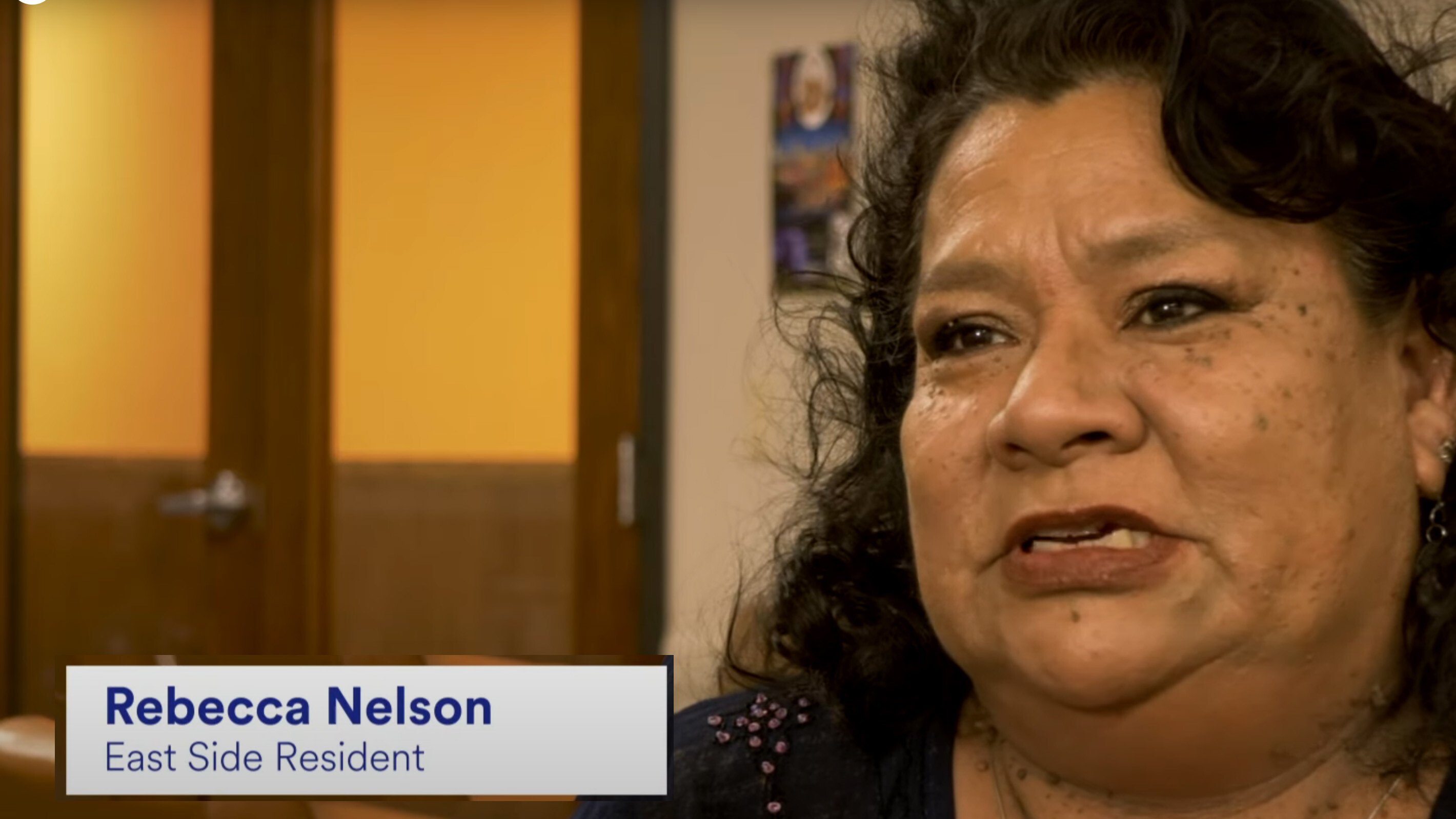
Since 1985, Twin Cities Habitat for Humanity has partnered with more than 1,800 homeowners in 100 cities all across the metro area. But this summer we’re beginning construction on our biggest development ever, which will become the largest concentration of Habitat homes in the Twin Cities. In the coming years, we’ll build nearly 150 homes—an entire neighborhood—in an area now known as The Heights.
We couldn’t be more excited to be building a new neighborhood on the Greater East Side of St. Paul. As we enter an era when we’ll be spending so much time on the East Side and inviting our community to join us, it’s important to recognize that we’re not building something new: there is already a thriving community on the East Side and there has been for a long time.
The land now known as The Heights is located in the northeast corner of St. Paul. It is part of the ancestral lands of the Dakota people; Ojibwe, Ho Chunk, and other nations also called it home prior to the arrival of large numbers of European settlers and the U.S. government’s eventual forced removal of indigenous people from the land. It was agricultural and grazing land until the 1920s when urban development reached the area.
Since the beginning of large-scale development, a high percentage of residents in the area have been new to the United States. The City of St. Paul’s Master Plan for this project describes it as the “landing spot for generations of new Americans for over 150 years.”
In 1921, the Hillcrest Golf Club opened at the corner of Larpenteur Avenue and McKnight Road as a public nine-hole course. During the same time, Jewish immigrants were arriving in the Twin Cities and settling mostly in Lowertown and on the West Side. Jewish immigrants became an upwardly mobile demographic population and had the American Dream of homeownership and a life of leisure in their sights. But the rising antisemitism of the era meant that some of the opportunities available to other families getting their start in the late 1940s were not available to Jewish families. Instead, they formed their own. In 1945, a group of Jewish businessmen pooled their resources and bought the Hillcrest Golf Club, expanded it to 18 holes, and opened it as a Jewish golf club.
Ron Zamansky’s father was an early member of Hillcrest. Ron remembers that “there was a great relationship between Hillcrest and the non-Jewish community around it. The club provided a livelihood for people who lived there; Hill-Murray students caddied at Hillcrest. Neighbors with houses on the 3rd hole nearby tended some gardens on the course's edge. We knew each other and were very friendly.”
The dream held by some members in Hillcrest’s heyday, that it might become the hub of a new Jewish neighborhood, was never realized. Families who grew up at Hillcrest now live all over the metro area, but a part of them still belongs to the neighborhood. “We are proud of our history in that neighborhood. We still feel connected to that land,” Ron said. “Hillcrest is still a frame of reference for the people who were members there. It is mentioned regularly in conversations to this day.”

A sign outside the former Hillcrest Golf Course notes its founding in 1945 as a Jewish club. Photo courtesy of Natalie Klasinski.
The City’s Hillcrest Master Plan describes the East Side as “a mosaic of people, institutions, and workplaces. It maintains its role as the gateway to St. Paul by welcoming new Americans from around the world. Neighborhoods have grown together to become one plural community.”
Xue Yang was born in Thailand and came to the U.S. as a young child. Both of her parents had family already living in St. Paul. Her husband Koua Xiong followed a similar path from Laos. When they were ready to buy a home, although they both worked in Anoka County, they chose to buy on the East Side to stay close to family. Xue and Koua bought their Habitat home on the East Side in 2019. They love the neighborhood because it has plenty of parks, schools, and small markets.
“We go to Hmong Village—you see other immigrants from other areas come there for things they can’t find at Target or Cub,” Xue said. “Other ethnic groups are setting up shop there—there are Somali pop-up markets, Karen garden shops, Mexican families shop there too. People might look down on the East Side but it’s such a beautiful mix of people.”
Xue’s sentiments are echoed by Lisa Theis, Executive Director of the Greater East Side Community Council. The neighborhood is thriving and diverse, she says, but it has suffered from a lack of resources and investment. “We haven’t had the eyes of city or state decision-makers.”
Lisa and the Community Council are incredibly excited about the new development at The Heights. “Hillcrest has been on our radar for a long time,” she said. “It’s a big piece of real estate! When the golf course closed, we thought: what next? It sat empty for a long time. We knew we needed housing for people who live here now. When we heard the city and Port Authority were interested in developing it, we made it known that we need large employers, good jobs, and affordable homes. We were so excited when Habitat got involved. The Heights is a jewel—but you have to take care of the jewel’s setting, too.”
“The Heights is an amazing opportunity for folks on the East Side and all over to celebrate this neighborhood. It has affordable starter homes, a strong sense of family. Kids grow up, move out to the suburbs, and move back. The Heights is one more reason to stay here. This neighborhood has been strong, cohesive, and looking out for itself for a long time.”
Everybody’s talking about The Heights; there’s lots of neighborhood chatter. This is a once-in-a-lifetime opportunity for the City, the St. Paul Port Authority, and Twin Cities Habitat for Humanity. But we recognize we’re building in an existing vibrant community, so our work is focused on relationships, not transactions. We’re building relationships, engaging neighbors, and investing deeply in the future of this community.
When Lisa heard that Habitat was selected as a development partner for The Heights and would be hosting the Jimmy & Rosalynn Carter Work Project there, she reached out to us. Shereese Turner, our Chief Program Officer, and Portia Jackson, Director of Programs and Services, met Lisa at a Hmong restaurant on the East Side. “It was jam-packed with people from all walks of life,” Shereese said, “and they were playing R&B music on the stereo. It was so homey and welcoming.”
We’re working to ensure this investment benefits those who lived in and contributed to the East Side community since long before we broke ground. There are a lot of renters on the East Side—and we believe many of them could become homeowners through Habitat. We’re working to connect with East Side renters who may be interested in buying homes at The Heights.
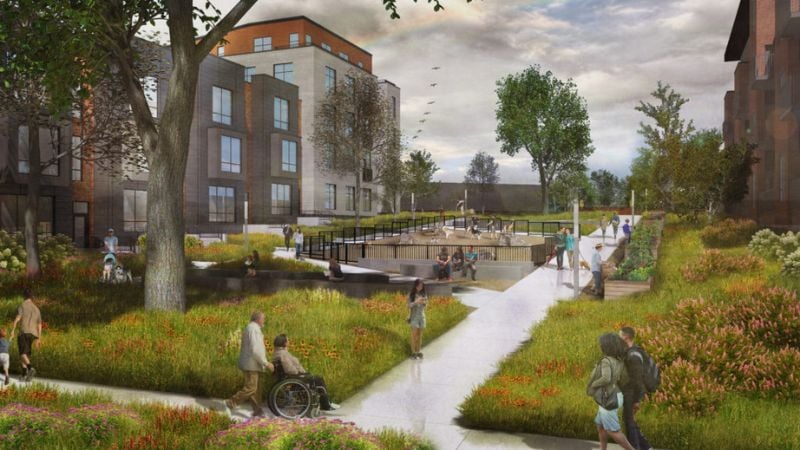
This architect's rendering of The Heights reflects the vision for it to be community-oriented, with plenty of public green space.
Shereese said, “We are not doing gentrification. We want to engage homebuyers that are already in the community. We already have a plan for where we should be doing door-knocking.” Our Community Engagement team is attending community meetings at the East Side Freedom Library. Excitement is palpable.
While Habitat’s Community Engagement team is connecting with the neighborhood through the Community Council, our Diversity & Inclusion Action Team is also connecting with the community. We recently launched an internal initiative to look more deliberately at how we engage with indigenous communities. We’re learning about the history of the land, connecting with Native organizers, and exploring ways—including but not limited to development of a land acknowledgement statement—that we can advance housing inequity in indigenous communities. The team recently talked with Rebecca Nelson, a board member at Elders Lodge and a number of other East Side community organizations.
“Historically, we've got one of the largest native populations here. But we don't have all the resources and the organizations that can help us,” Rebecca shared. “They're all in Minneapolis; they tend to forget about us, and the city government tends to forget about us over here. I'm fiercely fighting for St. Paul.”
Rebecca is a member of the Sisseton Wahpeton nation of South Dakota but grew up in St. Paul. “I was adopted by a white Scandinavian family when I was two weeks old, before ICWA [the Indian Child Welfare Act of 1978] came along and put a stop to that,” she said. “My story is unfortunately not unusual.” Her parents were living at Pine Ridge at the time, and eventually made their way back to St. Paul. They were both deeply involved in the East Side community—her father as a doctor and her mother as a pastor. Her grandfather, an engineer, helped build Gustavus Adolphus Church on Arcade. “So I feel a real deep connection to the East Side, even though I was always aware of being different."
About ten years ago, Rebecca had the opportunity to travel across the U.S. working on a food truck. “We only did powwows, and I learned to make frybread. I had this mindset that I didn’t belong because I was adopted and grew up in this Scandinavian family. But everyone just accepted me as part of the community, as Native.” That experience helped give her the confidence to run for the Payne Phalen Community Council in 2016; now she’s a central figure on the East Side, on the boards of multiple organizations that serve the broader neighborhood and specifically the indigenous community of the East Side.
Though it’s historically Dakota land, centuries of displacement mean that the East Side indigenous community now is from many different tribes and reservations. “I found out there are a lot of people from my reservation here, just down the block, that I had no idea about,” Rebecca said. “I feel connected here.”
As Habitat starts to build at The Heights, we acknowledge the history of the land and neighborhood. We appreciate the diversity and inclusivity that strengthen this community. We recognize the generations of East Siders who contributed to the vibrancy of this area, and we are grateful for the opportunity to invest in its future.
Your gift unlocks bright futures! Donate now to create, preserve, and promote affordable homeownership in the Twin Cities.
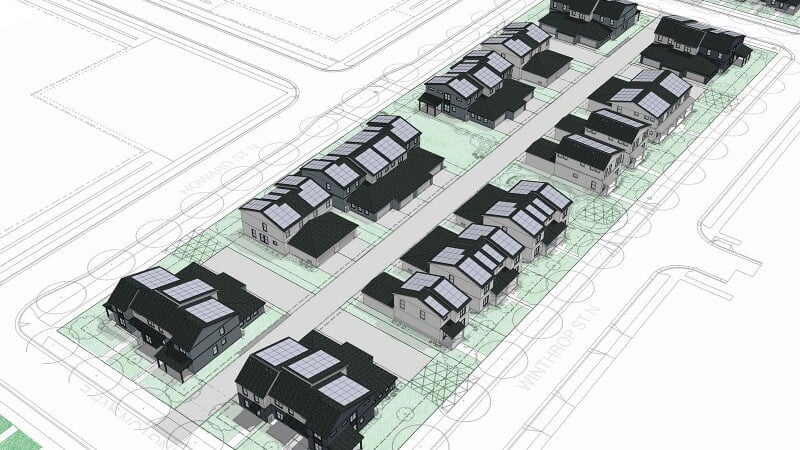
Twin Cities Habitat for Humanity begins site work this week and house construction later this month at The Heights on the East Side of St. Paul. Over...
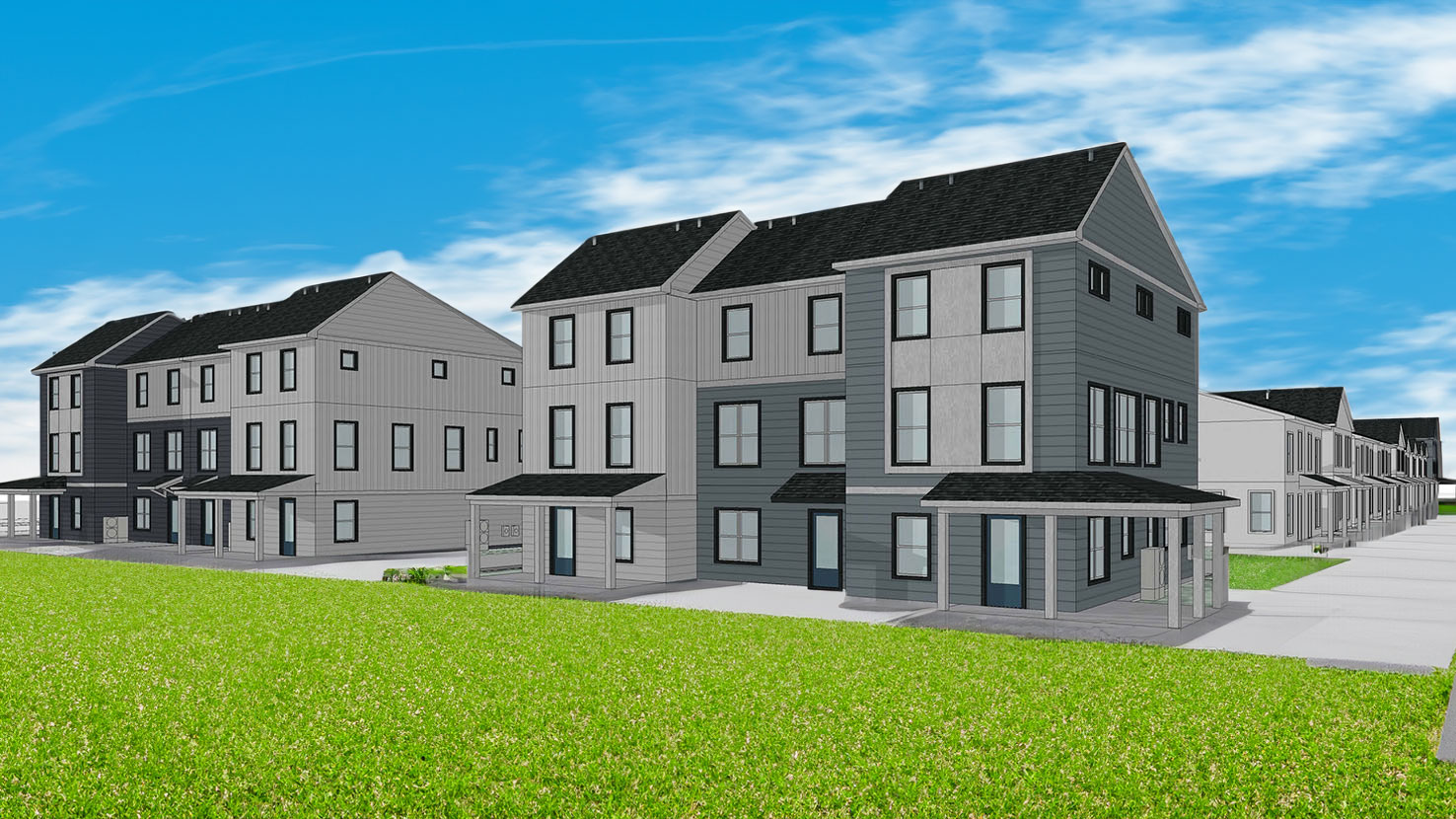
The Greater East Side of St. Paul is a vibrant community with plenty of small businesses, arts and culture organizations, and a strong and...
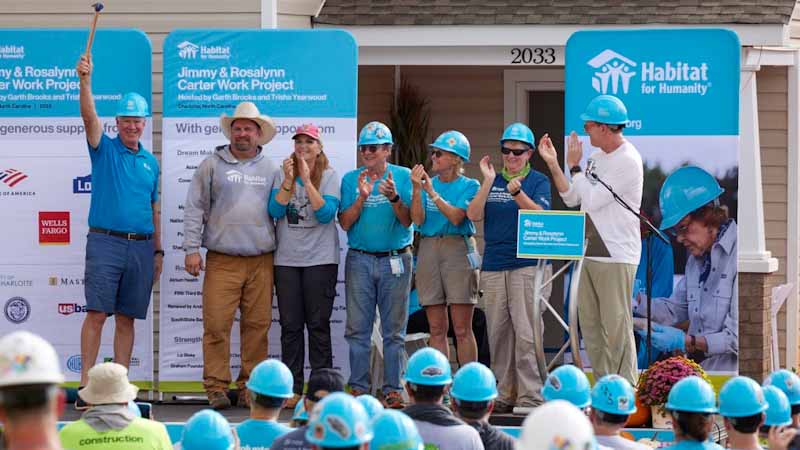
Get excited! The Opening Ceremony for the 2024 Jimmy & Rosalynn Carter Work Project is just 100 days away. We couldn’t be more honored and thrilled...